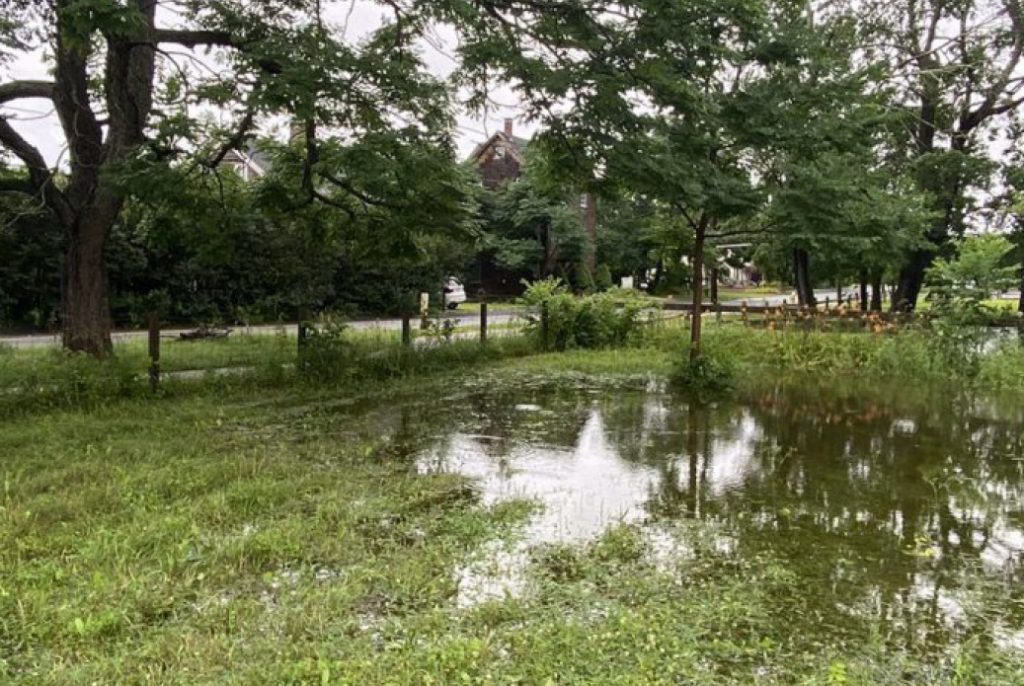By Siddarth Motwani, LI Sound program assistance, and Laura McMillan, director of communications
Tropical Storm Elsa made landfall in the early hours of Friday, July 9, 2021 dropping up to 5 inches of rain on New York and Connecticut in less than 12 hours. It was the earliest named hurricane on record, but the season was just getting started: a few weeks later, Henri came ashore at the Connecticut-Rhode Island line with blustery winds and heavy rains. And on September 1, Ida stormed the northeast, bringing even more deadly and destructive flash flooding across the region.
Elsa, Henri, and Ida offer a grim preview of the hurricane seasons we expect to see more of as climate change warms the waters that fuel hurricane strength. Our coastal, riverside, and inland communities must prepare, and we must redouble efforts to avoid the worst outcomes by reducing climate pollution.

Rain from Elsa made its way across impervious surfaces before finally being captured by open space in Guilford, CT. This meadow was submerged in 3 to 6 inches of water that would have otherwise entered the Sound through the West River. © Tim Sperry
Below are reflections from experts across Save the Sound’s programs, offering diverse perspectives on the impact of Elsa through the lenses of their work.
Staff Attorney Kat Fiedler:
“Each time we have an event like this, massive amounts of sewage flow into our waters, requiring beaches to be closed. We need to invest in systems now that can handle stormwater flows and infiltration, so that we don’t continue to pour raw sewage and other pollution into waterways used for swimming, subsistence fishing, and boating. These aggravated sewage spills will do the most harm in communities already suffering from environmental injustice and neglected infrastructure. We know what we are going to face in the climate crisis, not just because of climate modeling but because the climate crisis is here. We know what we need to do.”
Climate & Energy Attorney Charles Rothenberger:
“Coupled with high heat days that make air conditioning more necessary, these storms are making ever more urgent the need to increase the resiliency of our electricity grid. The Connecticut state legislature has authorized an expanded microgrid program to cover resilience projects and prioritize projects in vulnerable communities and set a 1,000 MW target for battery storage deployment by 2030, and the Connecticut Public Utilities Regulatory Authority recently issued a draft electric storage incentive plan. Enhancing the resilience of the grid is an essential complement to increasing the supply of clean renewable energy that will reduce our contribution to climatic warming.”
New York Natural Areas Coordinator Louise Harrison:
“Much of Long Island’s electric service is above ground, so it’s easy to knock out power when there is a lot of wind, or when wind combines with heavy branches. High water-table conditions can arise from high rainfall, especially near waterways; storm surge combined with that can cause severe flooding in some areas. Salt water moving into the coastal zones with surge lifts the groundwater and can cause septic failure and salt water intrusion into drinking water wells.”
Assistant Director of Ecological Restoration Anthony Allen:
“The good news is that we have the tools to mitigate the impacts of the next Elsa, and the one after that. Living shorelines and wetland restoration provide an effective natural buffer to storm surge along our coasts and flooding in our rivers, while also providing critical habitat for threatened species. Removing derelict dams and replacing undersized culverts reduces the risk of infrastructure failure leading to road closures and loss of property or life, while securing the incredible benefits of free-flowing rivers. Watershed planning and green stormwater infrastructure can greatly reduce the polluted runoff that makes it into our rivers, which in turn keeps our waters safe and our beaches open.”
Save the Sound President Curt Johnson:
“As I told senators and representatives in DC in July, this summer the existential threat of climate change has become real health and ecological dangers. Connecticut towns reported that severe deluges from Elsa dumped 115 million gallons of raw sewage and polluted stormwater into our rivers and into the Sound. Leaky pipes, combined with the earliest named storm on record, equates to climate disaster.
“Together we must support the Climate and Transportation Initiative and invest in offshore wind to lessen the climate pollution driving these disasters. Let’s use nature-based solutions to capture flood waters and protect our coastal communities from storms. Let’s fight to save our wonderful slice of this magnificent blue planet for ourselves and for future generations.”
A longer version of this article is available on Save the Sound’s website at savethesound.org/2021/08/13/elsa-foreshadows-climate-changes-human-and-environmental-impacts. ■
